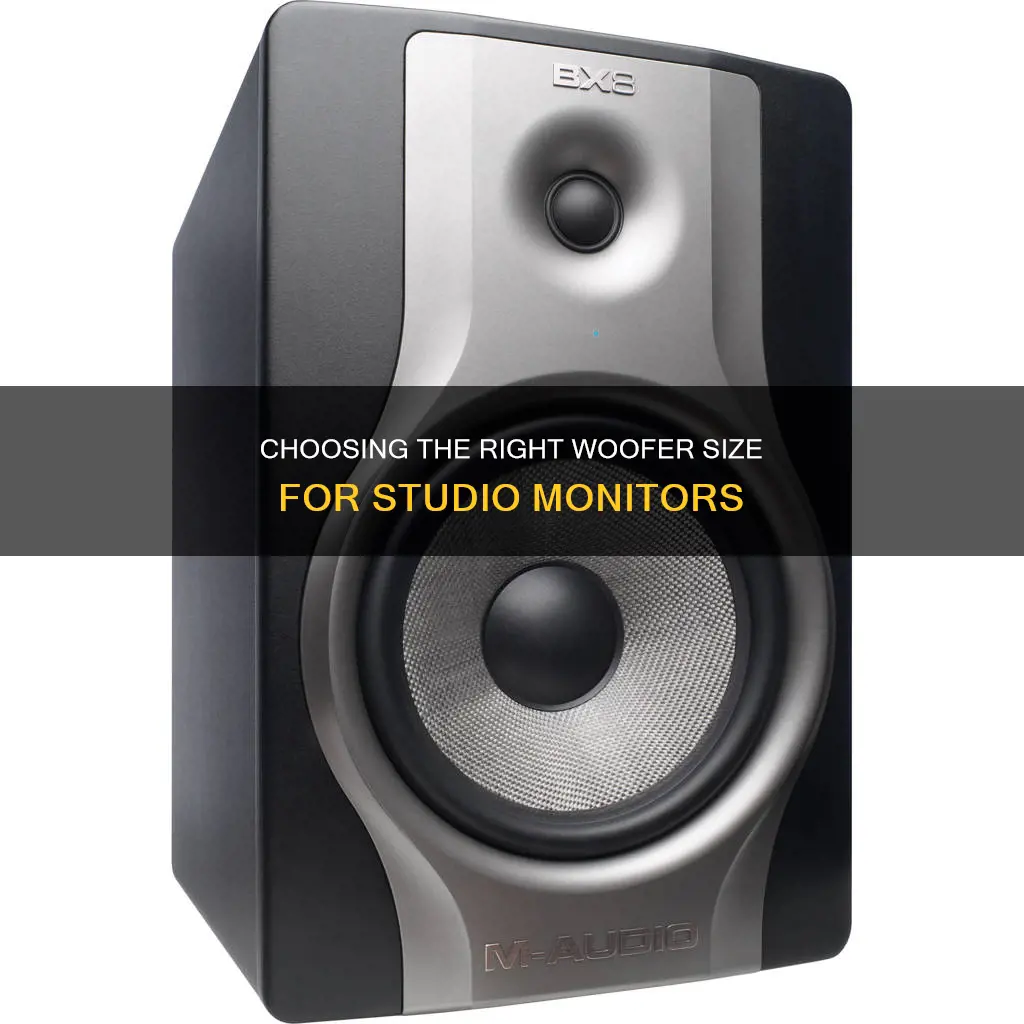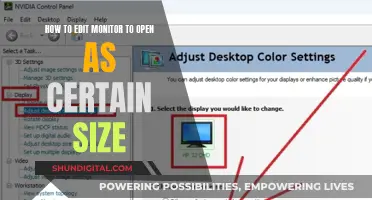
When it comes to studio monitors, there are a few things to consider when deciding on the woofer size. Firstly, the size of the woofer will impact the frequency response, with larger woofers capable of moving more air and reproducing lower frequencies. For example, if you produce EDM, you will need a better low-frequency response and a bigger woofer size. Secondly, the size of your room and music style are important factors. Smaller speakers may offer better midrange and high-frequency response due to their smaller size, and they are also more suitable for smaller spaces. Additionally, the placement of the monitors is crucial, as you want to form an equilateral triangle with your head when seated. Lastly, the power handling of the system will impact the overall sound and dynamic range, with higher wattage providing more headroom and definition. When deciding on the woofer size for your keyboard studio monitor, consider the size of your room, music style, and desired frequency response to make an informed choice.
| Characteristics | Values |
|---|---|
| Woofer size | 5-8 inches |
| Use case | Recording, editing, mixing, mastering audio |
| Monitor type | Active or passive |
| Power | Higher wattage = more headroom |
| Amplifier configuration | Single-amp, bi-amp, tri-amp |
| Speaker construction materials | Paper, Kevlar, aluminum alloys |
| Cabinet type | Ported or closed |
| Features | EQ, room correction, subwoofer |
| Placement | Stereo pair forming an equilateral triangle with the listener's head |
| Isolation | Speaker stands with isolation pads |
What You'll Learn

Studio monitor size depends on room size and music style
The size of studio monitors depends on two main factors: the size of the room and the style of music.
Room Size
The general rule is that smaller rooms require smaller studio monitors. This is because the bass response of a speaker is dependent on the size of the room it's in. The larger the woofer, the lower the bass it can reproduce, but this also means a bigger room is needed to hear it accurately. For example, an 8-inch monitor would be far too big for a small room as the bass would be far too powerful and cause a lot of problems.
Music Style
The style of music you work on will also determine the size of the studio monitor needed. If you're working on genres like dance or hip-hop, it's important to hear the bass clearly and accurately, so a minimum speaker size of 6 inches is recommended, with larger sizes being ideal. If you're a singer/guitarist, you won't be generating very low bass frequencies, so a 5-inch monitor or smaller will be fine.
Other Considerations
It's important to note that speaker size is not the only factor that determines sound quality. Other factors, such as driver quality, amplifier power, and speaker placement, can also have a significant impact on the overall sound of your studio. Additionally, the wattage of the studio monitor is significant for sound levels without distortion. For beginners, 50-75 watts per channel is a good starting point.
In summary, when choosing the size of studio monitors, consider both the room size and the style of music you'll be working on. For smaller rooms and singer/guitarists, a 5-inch monitor or smaller will suffice. For larger rooms and music styles that require clear and accurate bass, a minimum of 6-inch speakers is recommended, with larger sizes being ideal.
Internal Fetal Monitoring: When to Remove and Why
You may want to see also

Active vs. passive monitors
When it comes to active vs. passive studio monitors, there are several factors to consider.
Active Monitors
Active studio monitors have built-in amplifiers, making them simpler to use and set up. They don't require any additional equipment, such as external amplifiers or cables, and can be plugged directly into an audio source. The built-in amplifiers are designed specifically for the monitors, often resulting in better overall sound quality. Active monitors are also known for their convenience and performance, making them a popular choice for professional studios.
Passive Monitors
Passive monitors, on the other hand, require external amplifiers to function. This offers more flexibility as you can choose and upgrade the amplifier separately to find the perfect match for your monitors. Passive monitoring systems are modular, allowing for gradual upgrades and a more cost-effective progression to better-quality gear. However, they require dealing with extra rack gear and ensuring the amplifier matches the power rating and impedance of the monitors for optimal performance.
Factors to Consider
When deciding between active and passive monitors, it's important to consider your needs, preferences, and budget. If you want a simple, plug-and-play solution that is reliable and accurate, active monitors are a good choice. On the other hand, if you prioritize flexibility and are willing to put in some extra effort, passive monitors might be preferable. Additionally, the inherent problems of achieving a low sale price at the budget end of the market may impact the quality of active monitors in that price range.
Recommendations
For beginners or those on a limited budget, a decent set of passive monitors and a good amplifier can be a cost-effective option. As your needs and budget grow, you can upgrade the amplifier and then the speakers separately, allowing for a gradual progression to higher-quality monitoring. For professionals or those with higher budgets, active monitors in the mid to upper price range offer significant advantages, such as optimised power amps for each driver, optimised driver-protection circuitry, and more complex and precise line-level crossovers.
Monitoring Oracle Database Performance: Tips and Tricks
You may want to see also

Power and wattage
When it comes to studio monitors, power and wattage are important factors to consider. Studio monitors with higher wattage can deliver higher sound levels without distortion. For instance, a studio monitor with 50-75 watts per channel is suitable for beginners or small-to-medium-sized rooms, while bigger commercial studios may require 100 watts or more per channel. However, it's important to note that wattage alone doesn't determine sound quality. A well-designed, high-quality studio monitor with lower wattage can often outperform a cheaper one with higher wattage.
Studio monitors are designed for accuracy and precise sound reproduction rather than loudness. They have sensitive drivers, typically with a sensitivity of 83-88 dB, which means they can produce significant sound pressure levels with relatively low power input. The power rating of a studio monitor, measured in watts, indicates how much electrical power it can handle and convert into sound. A higher wattage generally corresponds to higher sound levels, but it's not the only factor that affects volume. The efficiency of the monitor and the sensitivity of the drivers also play a crucial role in determining the overall sound output.
When choosing the right wattage for your studio monitors, it's essential to consider the size of your studio and the type of audio you want to create. If you work with music genres that require a strong low-frequency response, such as EDM, a higher wattage and bigger driver size may be more suitable. On the other hand, smaller speakers often offer better midrange and high-frequency response due to their smaller size. Additionally, the acoustics of your recording space can significantly impact the performance of your studio monitors. Proper placement of the monitors, including maintaining an optimal distance from walls and using speaker stands, can help minimise the impact of room ambience on the sound.
In summary, when selecting studio monitors, focus on finding a balance between power, wattage, and other factors like driver size, room acoustics, and the type of audio you produce. While wattage is important, it's not the sole determinant of sound quality. By considering your specific needs and the characteristics of your studio space, you can choose studio monitors that provide an accurate and detailed sound reproduction without distortion.
Adjusting Text Size on LG 27 Monitors: A Simple Guide
You may want to see also

Driver types
When it comes to studio monitors, there are a variety of driver types and materials to choose from. The most common setup is a two-way design, with a woofer for low and mid-range frequencies, and a tweeter for high frequencies. Some monitors feature a third, dedicated midrange speaker for a three-way design.
The materials used in the construction of these drivers vary, with options including paper, Kevlar, and aluminium alloys. While these materials can have a significant impact on the sound of a speaker, it's important to focus on the application-specific benefits rather than getting caught up in the specifics of the materials.
The size of the woofer is an important consideration when choosing studio monitors. As a general rule, larger monitors can output more power and reproduce lower frequencies. However, it's crucial to match the monitor size to the room size; bigger, louder monitors can easily overload a small space. For most small to medium rooms, nearfield monitors with woofer diameters ranging from 3 to 8 inches are more than adequate.
When deciding on the appropriate woofer size, it's worth considering the type of music you produce. For example, if you're an EDM music producer, you'll need a better low-frequency response, so a bigger driver size would be more suitable. On the other hand, smaller speakers may offer better midrange and high-frequency response due to their ability to reproduce these frequencies more accurately.
In addition to woofer size, other factors such as driver quality, amplifier power, and speaker placement also play a significant role in the overall sound of your studio setup.
Ankle Monitors: Who Pays the Cost of Bail Freedom?
You may want to see also

Cabinet considerations
When choosing studio monitors, cabinet considerations are important as they can affect the sound quality and accuracy of the speakers. One of the main choices is between ported and closed cabinets. Ported cabinets have ports that help extend the frequency response lower for more bass. While this can be beneficial, the sonic accuracy of ported cabinets may not be as precise as closed cabinets. If the ports are on the back of the speakers and they are placed too close to a wall, the accuracy may be further compromised. In such cases, front-ported or closed cabinet designs may be preferable for more accurate monitoring.
The size of the room and the placement of the monitors are also crucial factors to consider. Smaller rooms may not be able to accommodate large monitors, and placing monitors too close to walls or corners can affect sound accuracy. In such cases, smaller monitors or front-ported/closed-back cabinet designs may be more suitable. Additionally, the listening distance should be considered, with nearfield monitors placed closer to the listener and midfield monitors placed further away in larger rooms.
Another aspect to consider is the power handling of the system, which affects not just the volume but also the dynamic range and headroom. Higher wattage provides more headroom, allowing for more precise adjustments and better transient detail. The amplifier configuration, such as single-amp, bi-amp, or tri-amp, also impacts the frequency response and definition, with bi-amp and tri-amp configurations typically offering a flatter response and greater definition by powering each speaker individually.
Studio Monitor Lifespan: How Long Do They Last?
You may want to see also
Frequently asked questions
Smaller rooms are not large enough to allow bass frequencies to fully develop, so a woofer size of 5 inches is ideal for home studios.
Active monitors have built-in amplifiers, making them simpler to use, while passive monitors require external amplifiers, offering more flexibility.
Nearfield monitors are designed to be placed fairly close to the listener's ears in a typical home studio.
For techno music, 8-inch woofers are ideal as they can really deliver the low end you need for mixing.
For EDM music, a bigger driver size is more suitable as it can move more air, which is necessary for reproducing lower-frequency sounds.







